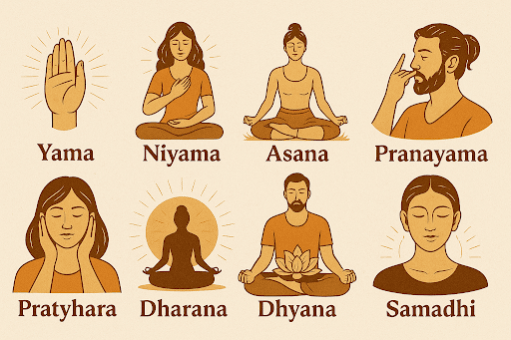
Yoga is one of the most profound gifts of Indian civilization to the world a timeless science that harmonizes the body, mind, and soul. Over centuries, this holistic discipline has evolved beyond its traditional context to become a global phenomenon. Yet, amidst the widespread popularity of yoga today, it is essential to revisit and reflect upon the true essence of yoga as described in our ancient scriptures and how it holds relevance in modern life, especially in light of the International Day of Yoga.
The Meaning of Yoga: More Than Just Postures
The word Yoga originates from the Sanskrit root 'yuj', which means "to unite". True yoga is when the mind is immersed completely in God. Jagadguru Shri Kripalu Ji Maharaj, the fifth original Jagadguru of the world, states that the meaning of yoga has been described vividly in our ancient scriptures.
The true vision of yoga was explained by Sage Patanjali in his renowned Yoga Sutras, where he expounded the concept of Ashtanga Yoga or the eightfold path. These eight limbs Yama, Niyama, Asana, Pranayama, Pratyahara, Dharana, Dhyana, and Samadhi form a systematic approach to achieve inner and outer purification. The first five (Yama, Niyama, Asana, Pranayama, Pratyahara) are primarily physical and behavioral practices, while the last three (Dharana, Dhyana, and Samadhi) are purely mental and spiritual.
Moving the Mind from the Material to the Divine
Dhyana means meditative contemplation on God or a divine saint (Mahapurush). When the mind becomes so absorbed that it loses awareness of the external world, it enters Dharana. Finally, when the mind transcends even this awareness and dissolves into a state of spiritual absorption, the yogi reaches Samadhi. This is the ultimate goal of yoga, where one becomes established in the Self.
This interpretation aligns with the teachings of ancient yogic seers like the Sanakadik Paramhansas of Satyuga, who declared in the Bhagavatam that true yoga is withdrawing the mind from the material world and fixing it on God. When the soul reunites with its source, that is Yoga in its highest sense.
Discipline, Devotion, and Detachment
According to Prem Ras Siddhant, a well-known book on philosophy authored by Jagadguru Shri Kripalu Ji Maharaj, the first two limbs Yama and Niyama are the foundation of yoga. They include ethical disciplines like truthfulness, non-violence, self-control etc.
In modern times, however, yoga is often reduced to Asanas or physical postures. While these are valuable for maintaining physical health, they represent just one part of the complete yogic journey. Many variations of asanas have developed in India and abroad, often diverging from the original teachings of Patanjali. Regardless, their purpose remains consistent keeping the body fit to serve as a vessel for spiritual pursuit.
Yoga: India's Gift to the World
Recognizing the global relevance of yoga, the United Nations declared June 21st as the International Day of Yoga in 2014, following India's proposal. This initiative not only placed yoga on the global stage but also inspired millions worldwide to explore its healing power.
International Yoga Day is now observed with immense enthusiasm across nations. Mass yoga sessions are held in schools, workplaces, and public parks, encouraging individuals of all ages and backgrounds to experience the transformative benefits of yoga. This day serves as a reminder that yoga is a universal science, not confined to any boundaries.
Even if one finds it difficult to meditate on God, Sage Patanjali advises meditating on a Saint a realized soul who is detached from the material world. Their presence purifies the mind and makes it more receptive to divine consciousness.
India, through Yoga Day, has once again demonstrated how its ancient traditions are not relics of the past, but relevant solutions to global challenges. Yoga is not just a cultural heritage, but a gift to humanity.








![Sky is the limit: IndiGo is now tenth largest airline by capacity globally; growth indisputable [details]](https://data1.ibtimes.co.in/en/full/767455/sky-limit-indigo-now-tenth-largest-airline-by-capacity-globally-growth-indisputable-details.jpg?w=220&h=135)